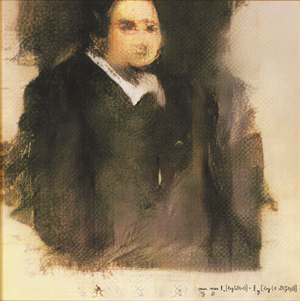I have always been a fan of classic art, dwelling in past affairs of the poetic conceptualizations that encapsulate the classic tastes. I enjoy the idea of preserving the past and expressing the immortal beauty of storytelling. I prefered my art to have set interpretations, the recognizable history right in front of you. Classic art is as it says, classic. I struggle with accepting new ideas; I like things the old way, the usual way. Because of this, I have always found it hard to grasp onto the general ideas of contemporary art. Contemporary art is a broad category and contains a massive and wide grasp as to what kind of art it contains. Contemporary art is generally defined as the modern art of today. I tended to stereotype the art form as to what I had assumed it was, cartoons and splatter paint.
For years, I renounced the idea of abstract art and unusual subject pieces and I had told myself that there was only one way to art and that was the classic style. During my senior year of high school, my art teacher noticed my stubbornness and guided me to broaden my horizons. She started me on these mini artist researches, in which I must find a contemporary artist every week and create a small piece of you own take while utilizing some of their techniques and styles. I did what any angsty teenager would’ve done and just googled “contemporary artist”, clicked the first link, and then substandardly created a sloppy piece so I could move on. With each link, I ended up finding myself becoming more and more intrigued by certain artists and their modern styles.
I eventually ran into the artist Peter Doig. Doig, born in Scotland circa 1959, was a contemporary artist who mainly focused on the ideas of magical realism, a topic that had heavily interested me in literature at the time. As a child, he continually moved with his family and was never provided a sense of stability guiding him to take on a more “free spirit” persona. At the age of seventeen, Doig dropped out of school but eventually took it upon himself to enroll in Wimbledon College to pursue a career in art even though “he had no real ‘natural drawing skill” (The Art Story). Doig really only began rising towards popularity in the early 1990s after he created this complex yet curious emotion behind his figure paintings.
At first, I struggled with his art and what he was trying to say because, again, I liked things to have a set meaning. Doig commented that "I am trying to create something that is questionable, something that is difficult, if not impossible, to put into words" (The Art Story). That irked me. Why couldn’t he just say what he painted? It was important to step back, to not zoom in so fast, and just look at the image. The colors he used were beautiful and while I had originally felt that some of his tactics were rudimentary, I just wasn’t taking in the whole picture. Curator Keith Hartley states that "he has an extraordinary visual memory which coalesces with his personal memories when he paints. So, an incident that he witnessed can be transformed by the interaction of all these elements into a painting that possesses an extraordinary resonance” (The Art Story). Through everything, what I loved about classic painting was the story being told, the deep roots of history and that is exactly what Doig is doing in his pieces. Yes, it may be more difficult to come up with the conclusion, but it is a story nonetheless. While he claims that its difficult to deduce the final say in his art, he know that the complexity is what provides the personal story for everyone else. He likes it to be unfinished for the observers, it holds its own energy that travels between people and interpretations that you can’t always get from classical artworks. I came to realize the importance and impact that contemporary art can make on the interpretations of storytelling and that everything in life doesn't have to be set in stone and above all, as Doig states, “I think that's what we find exciting about looking at other people's paintings, something that's living - not inert or complete or perfect.”
“Biography for Peter Doig (Born 1959).” Peter Doig Biography, www.peterdoigprints.info/biography.php?cur=GBP.
“Peter Doig Biography, Life & Quotes.” The Art Story, www.theartstory.org/artist-doig-peter-life-and-legacy.htm#biography_header.
Saatchi Gallery. “Peter Doig.” Cecily Brown - Pyjama Game - Contemporary Art, www.saatchigallery.com/artists/peter_doig.htm.









